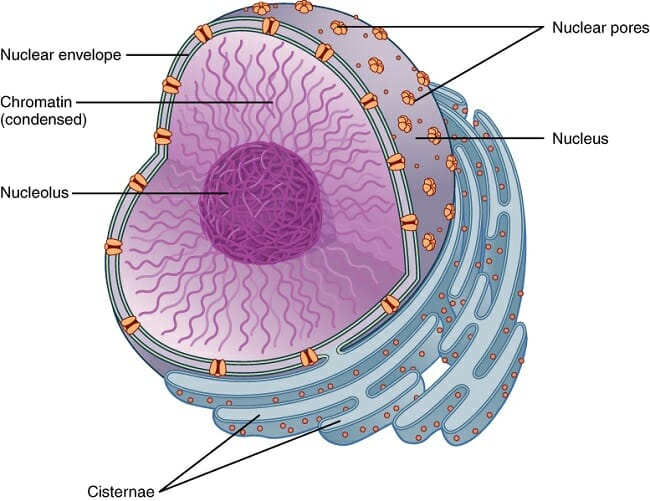Class 10 - Science
Chapter 9 - Heredity and Evolution
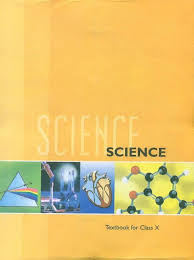
Top Block 1
Page 143
Question : 1. If a trait A exists in 10% of a population of an asexually reproducing species and a trait B exists in 60% Of the same population, which trait is likely to have arisen earlier ?
Answer :
As species are asexually reproducing, there would be only very minor differences generated due to small inaccuracies in DNA copying, so trait B, which exists in 60% of the same population may get inherited earlier while trait A, which exists in 10% of the population may be originated late due to variations. Thus, trait B have arisen earlier since it is present in 60% of the same population.
Question : 2. How does the creation of variations in a species promote survival ?
Answer :
Natural selection selects the individuals having useful variations which ensure their survival in the prevailing conditions of environment. Variant individuals that can withstand or cope with prevailing environment will survive better and will increase in number through differential reproduction.
Page 147
Question : 1. How do Mendel’s experiments show that traits may be dominant or recessive ?
Answer :
Mendel took pea plants with contrasting characteristics — tall plant and dwarf (short) plant. On cross pollination, he got all tall plants in F1 generation. Then by self-pollination of F1 tall plants, he produced second generation (F2) consisting of tall and short plants in the ratio of 3 : 1. Then he concluded that, ‘T’ (tall) trait is dominant while ‘t’ trait for shortness is recessive.
Question : 2. How do Mendel’s experiments show that traits are inherited independently ?
Answer :
In a dihybrid cross made by Mendel, it was observed that when two pairs of traits or characters were considered; each trait expressed independent of the other. Thus, Mendel was able to propose the Law of Independent Assortment which says about independent inheritance of traits.
Question : 3. A man with blood group A marries a woman with blood O and their daughter has blood group O. Is this information enough to tell you which of the traits — blood group A or O is dominant ? Why or why not ?
Answer :
No. This information is not sufficient to determine which of the traits − blood group A or O − is dominant. This is because we do not know about the blood group of all the progeny.Blood group A can be genotypically AA or AO. Hence, the information is incomplete to draw any such conclusion.
Question : 4. How is the sex of the child determined in human beings?
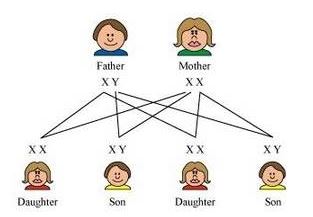
Answer :
The females carry two X-chromosomes. Females produce one type of gametes (eggs) with same type of chromosomes (22 + X). Males have one X and one Y- chromosome. Among the male gametes, half of the sperms carry X-chromosome (22 X) and half carry Y-chromosome (22 + Y). Thus, female is homogametic and male is heterogametic. When a sperm carrying X- chromosome fertilises an egg, the zygote develops into female (XX condition). When sperm carrying Y-chromosome fertilises an egg, the zygote develops into a male (XY condition). Thus, sex is determined at the time of fertilisation.
Page 150
Question : 1. What are the different ways in which individuals with a particular trait may increase in a population ?
Answer :
Different ways are : variation, natural selection and genetic drift (isolation).
Question : 2. Why are traits acquired during the lifetime of an individual not inherited ?
Answer :
Because acquired characters bring changes only in non-reproductive tissues and cannot change the genes of the germ cells. Thus, acquired traits cannot be passed to next generation.
Question : 3. Why are the small numbers of surviving tigers a cause of worry from the point of view of genetics ?
Answer :
(i) If any natural calamity occurs and kills these small number of surviving tigers, they can become extinct resulting in the loss of some genes forever.
(ii) Small number will lead to little recombination and, therefore, lesser variations. These both are very important for giving better survival chances to the species.
(iii) Less number of species means lesser extent of diversity and lesser number Of traits which reduces the chances of adaptability with respect to the change in the environment.
Page 151
Question : 1. What factors could lead to the rise of a new species ?
Answer :
Genetic variations, natural selection and reproductive isolation could lead to the rise of a new species.
Question : 2. Will geographical isolation be a major factor in the speciation of a self-pollinating plant species ? Why or why not ?
Answer :
No, because pollination occurs on the same plant in self-pollinating plant species.
Question : 3. Will geographical isolation be a major factor in the speciation of an organism that reproduces asexually ? Why or why not ?
Answer :
No, because asexual reproduction involves single parent or organism.
Page 156
Question : 1. Give an example of characteristics being used to determine how close two species am in evolutionary terms ?
Answer :
Homologous organs, analogous organs and vestigial organs help to identify evolutionary relationships amongst the species.
Question : 2. Can the wing of butterfly and the wing of a bat be considered homologous organs ? Why or why not ?
Answer :
No, wing of a bat and wing of a bird cannot be considered as homologous organs because they have different basic structure.
Question : 3. What are fossils ? What do they tell us about the process of evolution ?
Answer :
Fossils are the impression or remains of ancient life found preserved in the sedimentary rocks. Fossils are direct evidences of evolution. Fossils also help to identify evolutionary relationship between apparently different species. They also tell about the extent of evolution that has taken place.
Page 158
Question : 1. Why are human beings who look so different from each other in terms of size, colour and looks said to belong to the same species ?
Answer :
They look different because of interaction of genes with environment which results in change in their appearance. But they belong to the same species as they have same number of chromosomes and can breed among themselves.
Question : 2. In evolutionary terms, can we say which among bacteria, spiders, fish and chimpanzees have a ‘better body design’ why or why not ?
Answer :
No, because different designs are the product of evolution and different species have different body design to suit or adapt to their environment.
Page 159
Question : 1. A Mendelian experiment consisted of breeding tall pea plants bearing violet flowers with short pea plants bearing whfte flowers. The progeny all bore violet flowers, but almost half of them are short. This suggests that the genetic make-up of the tall parent can be depicted as
(a) TTWW (b) TTww
(c) TtWW (d) TtWw
Answer :
(c) Genetic make-up of tall plant can be depicted by TtWW.
Question : 2. An example of homologous organs is
(a) our arm and a dogs fore-leg.
(b) our teeth and an elephants tusks.
(c) potato and runners of grass.
(d) All of the above.
Answer :
(d) Both organs in all options have same basic structural design but have different functions and appearance.
Question : 3. In evolutionary terms, we have more in common with
(a) a Chinese school-boy.
(b) a chimpanzee.
(c) a spider.
(d) a bacterium.
Answer :
(a) A Chinese school-bpy is also a human being.
Question : 4. A study found that children with light-coloured eyes are likely to have parents with light-coloured eyes. On this basis, can we say anything about whether the light eye colour trait is dominant or recessive? Why or why not?
Answer :
We can say that light eye colour trait is dominant because only dominant traits are expressed in the first generation.
Question : 5. How are the areas of study – evolution and classification— inteilinked?
Answer :
Evolution and classification are interlinked with each other in many ways. Classification is the most important term to explain evolution. It is based on the similarities and differences between two species or among two organisms. More closer the characteristics, the moedoser is the evolution and chances to be in the same group of classification. Thus, the classification of species is a reflection of their evolutionary relationship.
Question : 6. Explain the terms analogous and homologous organs with examples.
Answer :
Analogous organs are those organs which have different basic structural designs and developmental origins but have similar appearance and perform similar functions.
Examples: Wings of an insect and wings of a bat.
Homologous organs are those organs which have the same basic structural design and developmenta origin but have different functions and appearance.
Examples: Forelimbs of frog and forelimbs of human.
Question : 7. Outline a project which alms to find the dominant coat colour in dogs.
Answer :
A homozygous black (RB) male dog and a homozygous white (bb) female dog is taken and given to mate and produce offspring in F1 generation. If black colour is dominant out of every 4 dogs, 3 will be black and if white colour is dominant 3 out of 4 dogs will be white.
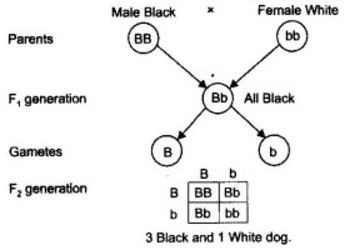
Mddle block 1
Question : 8. Explain the importance of fossils in deciding evolutionary relationships.
Answer :
Fossils and their study is useful to know about the species which are no longer alive. They provide evidence and missing links between two classes. They are helpful in forming a sequence of organisms in the pathway of evolution. Thus, fossils have importance in deciding evolutionary relationships.
Question : 9. What evidence do we have for the origin of life from inanimate matter?
Answer :
Stanley L. Miller and Harold C. Urey provided evidence regarding origin of life from inanimate matter. They assembled an atmosphere similar to that existed on early earth. The atmosphere had molecules like ammonia, methane, hydrogen sulphide and water, but no oxygen. The mixture was maintained at a temperature just below 100◦C and sparks were passed through the mixture of gases. At the end of a week, 15% carbon from methane had been converted to simple compounds of carbon like aminoacids which make up protein molecules. So, life arose afresh on earth.
Question : 10. Explain how sexual reproduction gives rise to more viable variations that asexual reproduction. How does this affect the evolution of those organisms that reproduce sexually ?
Answer :
Variations occurring during sexual reproduction may be due to:
(i) Separation of homologous chromosomes (by chance only) during gamete formation.
(ii) Crossing over (recombination) of homologous chromosomes.
(iii) Fertilisation of gametes to form zygote.
(iv) Errors during DNA copying or mutations. In asexually reproducing organism only errors during DNA copying or mutations cause variations. Since the extent of variations is much larger in sexually reproducing organisms, therefore, the chances of evolution is also much in sexually reproducing These variations enable the organisms to adapt themselves to the changing conditions and also help to face the struggle for Over the time, they and rise to new species.
Question : 11. How is the equal genetic contribution of male and female parents ensured in the progeny?
Answer :
Genetically organisms are of types
(i) Haploid : They have single set of chromosomes, where each chromosome is represented singly. As the chromosomes are the bearer of genes so haploids have single set of genes. A single gene determines the expression of character.
(ii) Diploid : ‘They have two sets Of homologous chromosomes, where the chromosome occur in pair, one maternal contributed by the mother through her ovum and the second Of the pair is contributed by the male parent through his sperm. The resultant cell zygote produces by the fusion of male and female gametes have two sets of chromosomes— each set contributed’ by each parent. In diploids a character is controlled by two genes/factors. Both the father and mother contribute practically equal amount of genetic material to the child. It means that each trait can be influenced by both paternal and maternal DNA.
Question : 12. Only variations that confer an advantage to an individual organism will survive in a population. Do you agree with this statement ? Why or why not ?
Answer :
No, many of the times the variations are not advantageous to an individual organism but still survive in a population, e.g., take the case of free ear lobe and attached ear lobe. Most of the other variations not only give survival advantage to an individual but also contribute to genetic drift. Thus, we can say that most of the variations lead to better adaptation of an organism to the changing environment. In this way, it gives survival advantage to that organism and will also survive in the coming population.
Multiple Choice Questions
Question : 1. An example of homologous organs is [NCERT]
(a) our arm and a dog’s foreleg
(b) our teeth and an elephant’s tusks
(c) potato and runners of grass
(d) All of the above
Answer :
(a) Our arm and a dog’s foreleg is the example of homologous organs.
Question : 2. The science, which deals with study of heredity and variations is called
(a) phylogeny
(b) embryology
(c) genetics
(d) palaeontology
Answer :
(c) The genetics is the study of heredity and variations and includes their occurrence, causes, benefits, disadvantages, significance, etc.
Question : 3. Archaeopteryx is a connecting link between
(a) reptiles and aquatic animals
(b) birds and insects
(c) reptiles and birds
(d) birds and dinosaurs
Answer :
(c) Archaeopteryx is a connecting link- between the reptiles and birds. It appears like a bird, but has other features which are present in reptiles, e.g. it has wings like bird, but teeth and tail like the reptilians.
Question : 4. For palaeontological studies a scientist will gather the evidences from
(a) study of homology
(b) study of analogy
(c) fossils
(d) All of these
Answer :
(d) Study of homologous and analogous organs indicates the origin and modification in organisms and study of fossils indicates the age and features of an organism.
Question : 5. In evolutionary terms, we have more in common with [NCERT]
(a) a Chinese school boy
(b) a chimpanzee
(c) a spider
(d) a bacterium
Answer :
(a) Chinese school boy because both of us belong to the same species, i.e. Homo sapiens.
Question : 6. Aditya was observing some organisms in lab and tried to compare them. The presence of which organs will confirm to him that they share evolutionary history?
(a) Analogous organs
(b) Paralogous organs
(c) Homologous organs
(d) None of these
Answer :
(c) Homologous organs are present in organisms who share evolutionary history. However, these organs perform different functions in different organisms.
Question : 7. New species may be formed if
I. DNA undergoes significant changes in germ cells. .
II. chromosome number changes in the gamete.
III. there is no change in the genetic material.
IV. mating does not take place.
(a) I and II
(b) I and III
(c) II, III and IV
(d) I, II and III
Answer :
(a) New species may be formed if the DNA changes are severe enough, such as a change in the number of chromosome. This leads to new variations.
Question : 8. Which of the following statements is not true with respect to variation?
(a) All variations in a species have equal chance of survival.
(b) Change in genetic composition results in variation.
(c) Selection of variants by environmental factors forms the basis of evolutionary processes.
(d) Variation is minimum in asexual reproduction.
Answer :
(a) All variations in a species do not have equal chances of survival. Some of the variations may be so drastic that the new DNA copy cannot work with the cellular apparatus it inherits. Such, a newborn cell dies soon.
Question : 9. Select the statement that describes characteristics of genes.
(a) Genes are specific sequence of bases in a DNA molecule.
(b) A gene does not code for proteins.
(c) In individuals of a given species, a specific gene is located on a particular chromosome.
(d) Each chromosome has only one gene.
Answer :
(b) Genes are stretches of DNA found on chromosomes of a cell. A gene contains information for making proteins in a cell. A specific gene is located on a particular chromosome in individuals of a given species.
Question : 10. If a round, green seeded pea plant (RRyy) is crossed with wrinkled, yellow seeded pea plant (rrYY), the seeds produced in F1 – generation will be [NCERT Exemplar]
(a) round and yellow
(b) round and green
(c) wrinkled and green
(d) wrinkled and yellow
Answer :
(a) The cross between RRyy and rrYY seeds will produce RrYy (round and yellow) seeds in F1-generation, because round and yellow are the dominant traits.
Question : 11. From the list given below, select the character, which can be acquired but not inherited. [NCERT Exemplar]
(a) colour of eye
(b) colour of skin
(c) size of body
(d) nature of hair
Answer :
(c) Acquired traits develop in response to the environment. The size of the body is an acquired trait because it can vary based on the availability of less or more food. The other three colour of eye and skin and nature of hair are characters inherited from the parents.
Question : 12. According to the evolutionary theory, formation of a new species is generally due to [NCERT Exemplar]
(a) sudden creation by nature.
(b) accumulation of variations over several generations.
(c) clones formed during asexual reproduction.
(d) movement of individuals from one habitat to another
Answer :
(b) Accumulation of variations over several generations forms new species. Genetic drift accumulates different changes in sub-populations of a species. Also, natural selection may also operate differendy in the different geographic locations. Eventually, different groups of new species will be formed.
Question : 13. Select the incorrect statement. [NCERT Exemplar]
(a) Frequency of certain genes in a population changes over several generations resulting in evolution.
(b) Reduction in weight of the organism due to starvation is genetically controlled.
(c) Low weight parents can have heavy weight progeny.
(d) Traits which are not inherited over generations do not cause evolution.
Answer :
(b) The weight reduction due to starvation will not change the DNA of the germ cells, because low weight is not a trait that is genetically controlled or inherited. Also, low weight parents may have heavy weight progeny.
Question : 14. In human males all the chromosomes are paired perfectly except one. This/these unpaired chromosome is/are
I. large chromosome
II. small chromosome
III. Y-chromosome IV X-chromosome
(a) I and II
(b) Only III
(c) III and IV
(d) II and IV
Answer :
(c) In human males, one pair called the sex chromosomes are unpaired. Here, one is a normal-sized X-chromosome while other is a short Y-chromosome. Women have a perfect pair of sex chromosomes, both called X.
Question : 15. Rajneesh was studying the fossils of two different types, fossil A was found in upper layer of Earth and B in deeper layers. What can be predicted regarding the age of these fossils?
(a) A has recently become extinct
(b) B has become extinct recently
(c) The time of extinction cannot be determined
(d) None of the above
Answer :
(a) Since, fossil A was found in upper layer of earth, it suggests that the organism has become extinct recently. Fossil B found in deeper layer must have become extinct long time ago and deposition of other layers occurred over it during this period.
Question : 16. A Mendelian experiment consisted of breeding tall pea plants bearing violet flowers with short pea plants bearing white flowers. The progeny all bore violet flowers, but almost half of them were short. This suggests that the genetic makeup of the tall parents can be depicted as [NCERT]
(a) TTWW
(b) TTww
(c) TtWW
(d) TtWw
Answer :
(c) Parent with genotype TtWW produce two types of gametes TW and tW, while the other with genotype ttww produce only one type of gamete W.
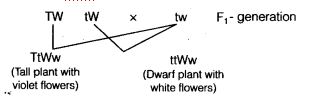
Additional Questions
Question : 1 What is heredity?
Answer :
The continuity of features from one generation to another is known as heredity. It is also defined as the transmission of traits from parents to the offsprings.
Question : 2 Name the plant on which Mendel performed his experiments.
Answer :
Mendel performed his experiments on the plant, Pisumsativum – the garden pea plant.
Question : 3 Define variation.
Answer :
Children do not resemble their parents completely. They possess characters obtained from both the parents. These changes in the phenotypic and genotypic characters are known as variations. Thus a given population of a species has indefinite variants.
Question : 4 Define a gene.
Answer :
A gene is a small portion of the DNA, with codes for a particular polypeptide or a protein. In other words, it is the functional unit of the DNA. It is also responsible for the transmission of hereditary characters from the parents to the offspring.
Question : 5 Write the expanded form of DNA.
Answer :
The expansion for DNA is Deoxyribonucleic Acid.
Question : 6 What are the components of the chromosome?
Answer :
A chromosome consists of two Chromatids joined together at the centromere. The chromaid consists of the DNA material wound over small protein molecules called histones.
Question : 7 What is a retrovirus?
Answer :
A retrovirus is a virus that has RNA as its genetic material instead of DNA. HIV virus is a retrovirus.
Question : 8 What is a sex chromosome?
Answer :
Chromosomes that are responsible for the determination of sex in an individual are known as sex chromosomes. There are two types sex chromosomes – the X chromosome and the Y chromosome. Males possess one X and one Y chromosome and females possess two X chromosomes.
Question : 9 How is sex determined in human beings?
Answer :
The male sex gametes have X and Y chromosomes, whereas the female sex gametes have two X chromosomes. When a sperm containing a Y chromosome fuses with the ovum containing X chromosome, the zygote develops into a male. When a sperm containing the X chromosome fuses with an ovum containing X chromosome, the zygote develops into a female. Thus the sex of an individual is determined by the sex chromosomes X and Y, which is present in the male chromosomes.
Question : 10 Define homologous organs.
Answer :
Homologous organs are those organs, which have similar origin and basic plan of development, but may or may not differ in their functions. The forelimbs of a human, a bird and a horse are homologous organs.
Question : 11 Explain Darwin’s theory of evolution.
Answer :
Darwin’s theory of evolution is also known as the Theory of Natural Selection or Darwinism. Darwin explained that despite having enormous potential of fertility, the population size of any kind of organism remains within a limit. It is due to the struggle between members of the same species and different species for food, space and mate. This struggle eliminates the unfit individuals. In other words, the fit organisms possess some variations, which are favourable and can leave the progeny to continue the variations. This is called Natural Selection.
Question : 12 Define Genetics. What is the contribution of Mendel in the field of genetics?
Answer :
The branch of biology that deals with the study of heredity and variations is known as Genetics. Gregor Johann Mendel was the first person to carry out experiments regarding the heredity of certain characters from one generation to another in a scientific manner. He worked mainly on the garden pea plant. His observations regarding the occurrence of contrasting characters in various generations of garden pea led him to interpret that these are controlled by units which he called, factors. These factors are today known as genes. He is also known as the Father of Genetics.
Question : 13 Where are the genes located? What is the chemical nature of genes?
Answer :
Genes are segments of the DNA, which is wound compactly into chromosomes. A gene is composed of a specific sequence of nucleotides. A nucleotide is made up of a nitrogenous base, a sugar molecule and a phosphate group.
Question : 14 During which stage can the chromosomes be seen clearly? Write the features of the eukaryotic and prokaryotic chromosomes.
Answer :
Chromosomes are distinctly visible during the Metaphase stage of mitosis of a cell. The features of eukaryotic and prokaryotic chromosomes are as follows
Eukaryotic chromosomes
1. They are present in large numbers.
2. In higher organisms it occurs in paired condition.
3. They are visible distinctly only during the metaphase stage of mitosis.
4. Each chromosome consists of two chromatics attached together by a centromere.
Prokaryotic chromosomes
1. They are simple in composition when compared to the eukaryotic chromosomes.
2. They are generally circular in shape.
3. There is only one chromosome in a cell.
Question : 15 Who provided the evidence of DNA as the genetic material? Write the names of the components of the DNA molecule.
Answer :
Frederick Griffith, Avery, Mc Leod and Mc Carty established that DNA was the carrier of the genetic information. The DNA molecule is a polynucleotide. A nucleotide is made up of a nitrogenous base, a sugar molecule and a phosphate group.
Question : 16 What do you understand by the double helical structure of DNA? Who proposed this structure?
Answer :
James Watson and Francis Crick proposed the double helical structure of the DNA. According to this structure,
• DNA molecule consists of two polynucleotide strands forming a double helix. Each helical turn has a length of 3.4nm in which ten nucleotides are present.
• Each polynucleotide strand has a backbone of sugar and phosphate. The nitrogenous base is attached to the sugar.
• The nitrogenous bases of the two strands of a double helix form a pair with the help of hydrogen bonds. Adenine pairs with thymine by two hydrogen bonds, whereas guanine pairs with cytosine by three hydrogen bonds.
• The hydrogen bonds hold the two strands of the helix together.
Question : 17 Describe the different types of chromosomes.
Answer :
The different types of chromosomes are,
Metacentric :
It is a chromosome with the centromere near the middle and the two chromatics are of equal lengths.
Sub-metacentric :
Here the centromere is situated slightly closer to one end than the other. Thus one chromatic is slightly longer than the other.
Acrocentric :
Here the chromosome is situated near one end of the chromosome. Thus one chromatic is very long while the other is very small.
Telocentric :
Here the centromere is situated at the tip of the chromosome.
Question : 18 How do embryological studies provide evidence for evolution?
Answer :
The embryology of different vertebrates provide very strong evidence favouring organic evolution. The early embryos of different vertebrates show striking similarities. This indicates common origin and ancestry of different vertebrates. Thus embryological studies provide direct evidence for evolution.
Question : 19 Define evolution. Describe the contribution of Lamarck.
Answer :
Evolution is referred to as the changes acquired by a species or a certain population of a species gradually over a long period of time. These changes should be heritable. Contribution of Lanark
According to the Theory of inheritance of acquired characters or Lamarckism, put forward by Lanark, the use and disuse of an organ leads to acquiring change in the features of that organ. These changes are also inherited by the offspring’s. The favorable variations caused due to use and disuse after a considerably long period of time, results in evolution of a new species.
Question : 20 How do homologous organs provide evidence in support of evolution?
Answer :
The presence of homologous organs indicates that all vertebrates have a common ancestry. Similarly, all organs and systems of the vertebrates show fundamental similarities, which point towards common ancestry.


